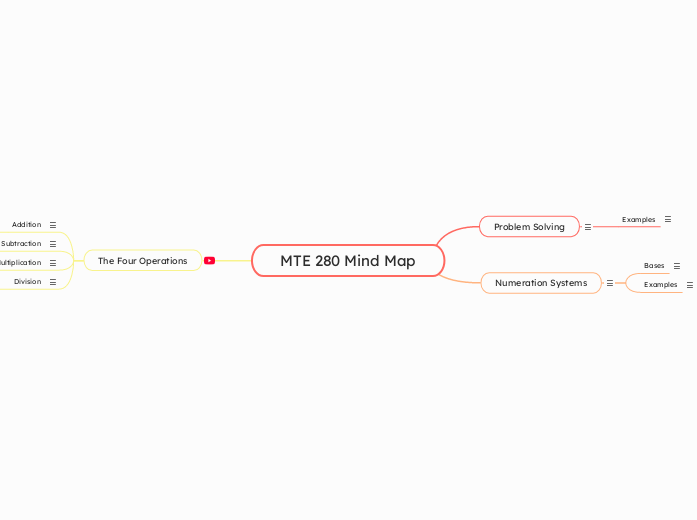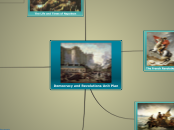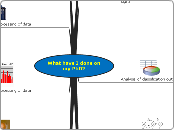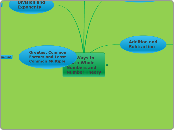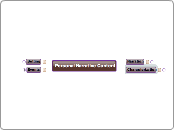MTE 280 Mind Map
The Four Operations
Division
Meaning: Sharing / splitting
Examples:
- John has 15 cookies. He puts 3 cookies in each bag. How many bags can he fill?
In this problem, students would determine the answer by using 15 manipulatives and creating groups of 3 until running out. They then would count how many groups of 3 they created to get an answer of 5 bags.
- John has 15 cookies. He puts the cookies into 5 bags with the same number of cookies in each bag. How many cookies are in each bag?
In this problem, students would determine the answer by using 15 manipulatives and creating 5 groups where they would place one manipulative in each group until they run out. They would then count how many they put in each group to get an answer of 3 cookies.
There are different ways students would engage with the problem to understand it's meaning. The second is more complicated as it's a longer process.
- American Standard (Long Division): The traditional method taught in most classrooms, where students divide from left to right, writing quotients above the dividend and subtracting at each step. If a number is too small to divide, the next digit is "brought down" to continue the process. While efficient, this method can be confusing for elementary students, as they often memorize the steps without understanding why they work, especially the concept of bringing down numbers.
- Place Value Method: A modified approach to long division that explicitly incorporates place value. Instead of simply bringing down digits, students break numbers into place values and divide each part separately. This method helps students understand what is actually happening in each step of division, making the process more meaningful rather than relying on rote memorization.
- Alternative Algorithm: This method breaks division into smaller steps using repeated subtraction. The divisor is subtracted in large, easy multiples (e.g., 10 groups of 16), followed by smaller chunks until the remainder is reached. The total number of groups is then added to find the quotient. This approach helps students understand division conceptually by viewing it as repeated subtraction rather than just a memorized process.
Image Link: https://drive.google.com/file/d/1l8hq3mIrBhq99PA2COuXE010Ct71oCfL/view?usp=sharing
Image Link: https://drive.google.com/file/d/1Ko6-kuoc7xStI6WNCqWaFEXZSsl3cAM2/view?usp=sharing
Multiplication
Meaning:
- Groups of the same quantities
- 3x4 = 3 groups of 4
- Repeated Addition
- 3x4 = 4+4+4
- Cortezian Product
- combining items from one group to another
- 3 shirts with 4 pairs of pants
Properties:
- Identity
- When you multiply a number by 1, its identity doesn't change
- ax1=a
- 5x1=5
- Commutative: order property
- order in which you multiply numbers doesn't matter
- axb = bxa
- 3x4 = 4x3
- Associative (grouping)
- can group numbers any way without changing value
- axbxc = (axb)xc = ax(bxc)
- 1x2x3 = (1x2)x3 = 1x(2x3)
- Zero
- When you multiply a number by zero the answer is always zero
- ax0=0
- 5x0=0
- Distributive
- When you multiply a number by the sum of 2 numbers, the answer is the same as multiplying each of the addends and add the partial products
- 3x9 = 3x(5+4) = (3x5)+(3x4)=15+12=27
- Helps kids find out answer to multiplication problems if they have trouble memorizing
- American Standard: The traditional method taught in most classrooms. Multiplication is performed from right to left, and when a product exceeds a single digit, students "carry" the extra value to the next place. While efficient, this method does not explicitly emphasize place value, which can make it confusing for some students.
- Place Value Method: This strategy breaks numbers down into their place values and multiplies each separately before adding the partial products. By emphasizing place value, this method helps students understand why multiplication works rather than just memorizing steps.
- Expanded Notation: Similar to the Place Value Method, this approach requires breaking numbers into expanded form (e.g., 23 as 20 + 3) before multiplying. Each part is multiplied separately, and then the partial products are added. This method reinforces place value and provides a clear step-by-step process for students struggling with multiplication.
- Lattice Method: A visual approach to multiplication that uses a grid to organize calculations. Each digit is multiplied separately, and the products are placed in diagonally divided boxes. The final product is determined by summing along these diagonals. While structured and systematic, this method does not emphasize place value and may not help students develop a deeper conceptual understanding of multiplication.
Image Link: https://drive.google.com/file/d/1DPqFFth6J-IrQn813H-NHQMVMqDHFnaz/view?usp=sharing
Subtraction
Meaning:
- Take away
- You have 4 cookies and eat 2 of them. How many cookies do you have left?
- Comparison:
- Ava has 3 cookies. Jack has 7 cookies. How many more cookies does Jack have than Ava?
- Missing Addend:
- Alyssa has 2 cookies, Sara gives her some and now she has 7 cookies. How many cookies did Sara give Alyssa?
Why are comparison and missing addend problems more confusing?
Nothing in the problem says to "take away" implying subtraction so telling students to take the difference doesn't make sense to them which is why students will find the answer by counting up and they often make mistakes!
- American Standard: The most commonly taught method, where subtraction is performed from right to left. If a digit is too small to subtract from, students "borrow" from the next place value by crossing out a digit and redistributing its value. However, this method can be confusing because it does not explicitly reinforce place value concepts.
- Reverse Indian Method: This strategy works from left to right. When borrowing is necessary, the adjustment is made based on the already subtracted values rather than the original numbers. At the end of the process, the remaining digits form the final answer.
- Left to Right: Similar to the Reverse Indian Method, but with an emphasis on place value. Borrowing is done by subtracting place value amounts (e.g., borrowing 10 instead of just adjusting digits). This method helps students who struggle to understand the logic behind subtraction.
- Expanded Notation: A great foundational method for teaching subtraction, as it explicitly shows place value. Each number is written in expanded form (e.g., 342 as 300 + 40 + 2), and subtraction is performed by place value. While it still follows right-to-left subtraction, the use of full place values (e.g., subtracting 10 instead of carrying a 1) makes the process clearer for students.
- Integer Subtraction Algorithm: More suitable for middle school students, as it involves negative numbers. Subtraction is done from right to left, even when it results in negative values. These negative numbers are recorded as part of the intermediate steps. Once the final leftmost digit is reached, students add all the values together, starting with the positive number and working up by incorporating the negative numbers. This method helps build an understanding of integer operations.
Image Link: https://drive.google.com/file/d/1s86KG6TQmMVZFCL8b0y7gOOmaeFpMwa4/view?usp=sharing
Addition
Meaning: Putting together; joining
Properties:
- Identity
- When you add zero to a number, its identity doesn't change
- a+0=0
- 5+0=0
- Commutative: order property
- when you add 2 numbers, order doesn't matter
- a+b = b+a
- 3+4 = 4+3
- Associative (grouping)
- can group numbers any way without changing value
- a+b+c = (a+b)+c = a+(b+c)
- 1+2+3 = (1+2)+3 = 1+(2+3)
Algorithms
Algorithms:
- American Standard: The most commonly taught method in classrooms. However, it can be confusing at first because it moves from right to left and does not explicitly represent place value. This often leads to questions like, "Why am I carrying the one?"
- Partial Sums: Instead of "carrying the one," each digit is added separately and written below the number to the left. While this method still moves right to left, it does not clearly emphasize place value.
- Place Value Method: Similar to Partial Sums but incorporates place value by adding zeros. When using this method, students are encouraged to verbalize the value of each number (e.g., saying “30” instead of just “3”), which helps reinforce place value concepts.
- Left to Right: This method aligns with how we naturally read numbers, making it more intuitive for students. It follows the same place value principles as the Place Value Method but is performed from left to right rather than right to left.
- Expanded Notation: A useful bridge between place value understanding and the American Standard method. Each number is expanded to show its place value (e.g., writing 237 as 200 + 30 + 7). Addition follows the right-to-left order of the American Standard method, but instead of carrying a “1,” students write out the full value (e.g., writing "10" instead of just carrying a 1). This helps clarify the reasoning behind carrying before transitioning to the American Standard method.
- Lattice Method: A visual approach to addition that involves drawing a grid and using diagonals to organize sums. While it provides a structured way to add, it does not reinforce place value or the underlying concepts of addition, which can make it harder for students to understand why it works.
Image Link: https://drive.google.com/file/d/16xG9J_slWiaP5EYMflsSo3Jrsxrt96gI/view?usp=sharing
Numeration Systems
Way to record QUANTITY
We use a base 10 system / decimal system
- positional system
- numbers get value from place they sit
- one - ten
- to the left: bigger x10
- to the right smaller x10
- Digits used: 0-9
Expanded Notation:
375 = 300 + 70 + 5
= (3x100)+(7x10)+(5x1)
= (3x10^2)+(7x10^1)+(5x10^0)
1078 = 1000 + 0 + 70 + 8
= (1x1000)+ (0x100)+(7x10)+(8x1)
= (1x10^3)+(0x10^2)+(7x10^1)+(8x10^0)
931 = 900+ 30 + 1
= (9x100)+(3x10)+(1x1)
= (9x10^2)+(3x10^1)+(1x10^0)
Compare and Contrast the numbers in different bases:
- 34 (base 5) ___ 34 (base 6)
- For this problem, we have the same amount of ones, but when you move to the second place we have 3 groups of five and 3 groups of 6. 3 groups of 6 will result in a larger number so 34 (base 6) is greater than 34 (base 5)
- 4 (base 5) ___ 4 (base 6)
- In this problem all you have is ones and because both have the same number of ones it doesn't matter what the base is so they are equal.
- 111 (base 2) ___ 7
- In this problem it's easiest to rewrite 111(base 2) as a base 10 so that you can more easily compare. So, you have 1 group of 4, 1 group of 2, and one 1. If you add 4+2+1 you get 7 so the numbers are equal.
- 100 (base 2) ___ 18 (base 9)
- For this problem, it's easiest to chane both of the numbers as base 10. for 100 (base 2) you have one group of 4 and nothing left over. For 18(base 9) you have 1 group of 9 and 8 ones so 9+8 = 17. 17 is greater than 4 so 18 (base 9) is the greater number.
- 23 (base 6) ___ 23 (base 5)
- This problem is similar to the first one because since the numbers are the same and the only difference is the bases, the larger base is greater because it shows that the 2 represents a greater quantity (2 groups of 6> 2 groups of 5).
Remember: Numbers can only use digits less than the base so an error in a problem may be that the number has a digit greater than the base itself which cannot be the case.
Write 12 in each base
- Base 9 = 13 (base 9)
- Base 8 = 14 (base 8)
- Base 7 = 15 (base 7)
To solve these problems you can draw 12 x's to represent the quantity. Then box however many the base is and this represents how many groups of the base you have. The leftover is your ones. So 13 (base 9) really means that in the number 12 you can make one group of 9 and then you have 3 ones left over.
Write the base 10 number as the given base:
- 29 = 1002 (base 3)
- ones
- 3s
- 9s
- 27s
- You can make one 27, and have 2 ones left over.
- 69 = 1000101 (base 2)
- ones
- 2s
- 4s
- 8s
- 16s
- 32s
- 64s
- You can make one 64 and then you have 5 left over so you can make one 4 and then you have one 1left over.
- 115 = 430 (base 5)
- ones
- 5s
- 25s
- You can use four 25s and then you have 15 left over so you can make three 5s and have none left over.
Image Link: https://drive.google.com/file/d/1l8hq3mIrBhq99PA2COuXE010Ct71oCfL/view?usp=sharing
Bases
Numbers can be represented with different bases:
Base 10:
digits 0-9
ones: 10^0
tens: 10^1
hundreds: 10^2
thousands: 10^3
Base 5:
digits 0-4
ones: 5^0
fives: 5^1
twenty-fives: 5^2
one-twenty-fives: 5^3
Base 3:
digits 0-2
ones: 3^0
threes: 3^1
nines: 3^2
twenty-sevens: 3^3
Expanded Notation can help us rewrite numbers in different bases:
1234 (base 5) = (1x5^3)+(2x5^2)+(3x5^1)+(4x5^0)
= (1x125)+ (2x25)+(3x5)+(4x1)
= 125+50+15+4
= 194
1234 (base 4) = (1x4^3)+(2x4^2)+(3x4^1)+(4x4^0)
= (1x64)+ (2x16)+(3x4)+(4x1)
= 64+32+12+4
= 112
1234 (base 3) = (1x3^3)+(2x3^2)+(3x3^1)+(4x3^0)
= (1x27)+ (2x9)+(3x3)+(4x1)
= 27+18+9+4
= 58
It works for decimals too!
Base 10:
First decimal place (1/10)
Second decimal place: (1/100)
Base 5:
First decimal place (1/5)
Second decimal place: (1/25)
Base 3: First decimal place (1/3)
Second decimal place:(1/9)
So...
31.2 (base 4) =
= (3x4^1)+(1x4^0)+(2x1/4)
= 12+1+2/4
= 13 2/4
221.2 (base 3) = (2x3^2)+(2x3^1)+(1x3^0)+(2x1/3)
= 18+6+1+2/3
= 25 2/3
Image Link: https://drive.google.com/file/d/1xhQV8cvIvl2O4-gpdQ1YCYyzGlQri-gh/view?usp=sharing
Problem Solving
Polya's Four Steps to Problem Solving
- Understand the Problem
- What are you asked to show or find out?
- Can you restate the problem in your own words?
- Can you draw a picture or diagram to help you?
- Devise a Plan
- Guess + Check
- Draw a picture
- Make a table
- Act it out
- Simplify
- Look for a pattern
- Work backwards
- Make an organized list
- Carry out the plan
- Usually easier than devising the plan
- Be patient: most problems are not solved quickly nor on the first attempt (don't get discouraged!)
- If one strategy does not work try a different one
- Look Back + Reflect
- Does your answer make sense? Is it reasonable?
- Did you answer all of the questions?
- Could you have solved this problem in a different way?
- What did you learn from this?
Examples
Problem Solving is a PROCESS: There are many ways to solve these problems!!
1) There are 12 basketball teams in a league. If each of the teams plays each of the other teams once and only once, how many games take place?
To solve: I started by creating a diagram where I represented each team with letters and I wrote them vertically. Next to the first team, team A, I wrote down all the teams they would play (B-L) This is the first 11 games played. I then moved onto to team B and wrote down the teams they will play (C-L), not including A because I already accounted for their game, which is 10 more games. I repeated this processes of writing out who each team will play without repeats and writing the number of games next to it. At the end I added up the number of games to get a total of 66 games.
2) I have four 3-cent stamps and three 7-cent stamps. Using one or more of these stamps, how many different amounts of postage can I make?
To solve: First, I recognized the combinations made with using just all the 3s, and then all the 7s. Then I drew a diagram to represent the stamps I had and drew lines to help me visualize the combinations you could create by using a mixture of 3 cent and 7 cent stamps. Eventually I realized that you can do the problem by adding the number of stamps you have and then multiplying them (for this problem you would do 4+3+(4x3)) but creating a visual was my first solution.
If I were teaching these problems to elementary school students I would have them use manipulatives to represent the situation rather than starting by writing it out as seeing it as a visual would be easier for them to comprehend and understand all the combinations.
Image Link: https://drive.google.com/file/d/1GSWBu4cvvQXefTZ22JmOLdYNRjK74VGJ/view?usp=sharing
